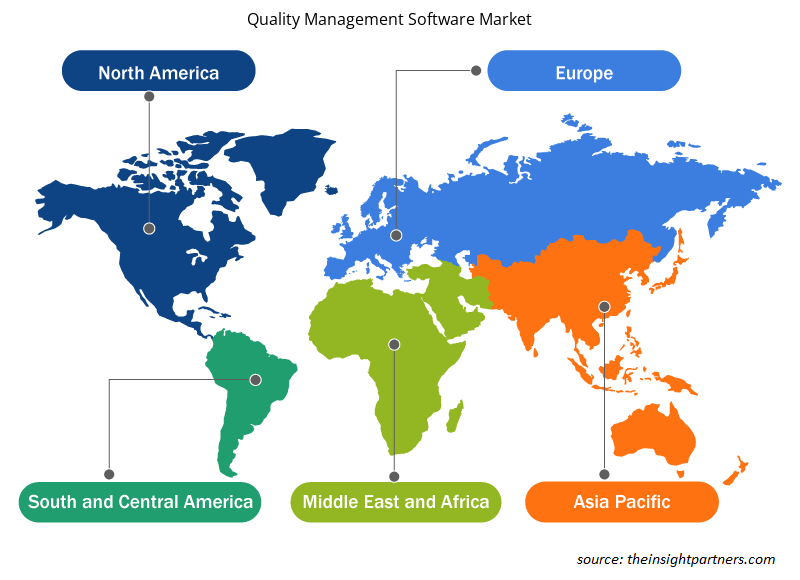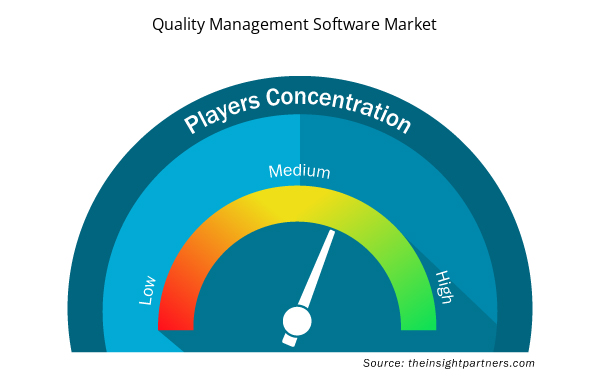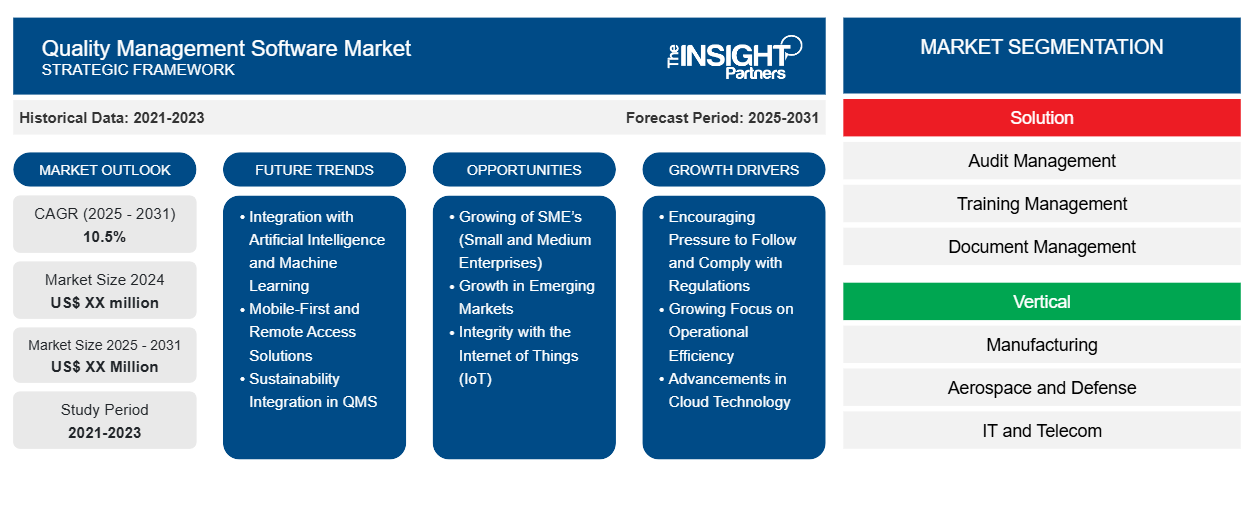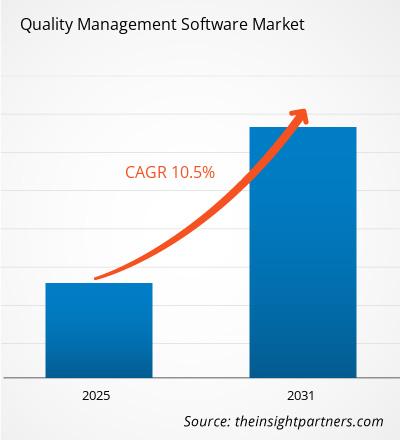Se espera que el mercado de software de gestión de calidad registre una CAGR del 10,5 % entre 2024 y 2031, con un tamaño de mercado que se expandirá de US$ XX millones en 2024 a US$ XX millones en 2031.
Este informe de investigación de mercado sobre el mercado de software de gestión de calidad se divide por tipo de solución, tipo de implementación, tamaño de la organización y sector vertical. La distribución regional incluye los principales mercados y regiones para brindar una descripción general global de la dinámica del mercado. Los valores de mercado por segmento están en dólares estadounidenses (USD) y vienen con estimaciones de CAGR que ayudan a comprender las tendencias, la dinámica y la competencia en varias regiones y aplicaciones.
Propósito del Informe
El informe Quality Management Software Market de The Insight Partners tiene como objetivo describir el panorama actual y el crecimiento futuro, los principales factores impulsores, los desafíos y las oportunidades. Esto proporcionará información a diversas partes interesadas del negocio, como:
- Proveedores/fabricantes de tecnología: Para comprender la dinámica cambiante del mercado y conocer las oportunidades potenciales de crecimiento, lo que les permitirá tomar decisiones estratégicas informadas.
- Inversionistas: Realizar un análisis exhaustivo de tendencias sobre la tasa de crecimiento del mercado, las proyecciones financieras del mercado y las oportunidades que existen en toda la cadena de valor.
- Órganos reguladores: Regular las políticas y vigilar las actividades del mercado con el objetivo de minimizar los abusos, preservar la confianza de los inversores y defender la integridad y la estabilidad del mercado.
Segmentación del mercado de software de gestión de calidad
Solución
- Gestión de auditoría
- Gestión de la formación
- Gestión de documentos
- Gestión de quejas
- Gestión de CAPA
- Registro de producto
- Control de cambios
- Gestión de calidad de proveedores
- Gestión de EH y S
Vertical
- Fabricación
- Aeroespacial y Defensa
- TI y telecomunicaciones
- Bienes de consumo y venta minorista
- Cuidado de la salud
- Energía y servicios públicos
Personalice este informe según sus necesidades
Obtendrá personalización en cualquier informe, sin cargo, incluidas partes de este informe o análisis a nivel de país, paquete de datos de Excel, así como también grandes ofertas y descuentos para empresas emergentes y universidades.
- Obtenga las principales tendencias clave del mercado de este informe.Esta muestra GRATUITA incluirá análisis de datos, desde tendencias del mercado hasta estimaciones y pronósticos.
Factores impulsores del crecimiento del mercado del software de gestión de calidad
- Presión para seguir y cumplir con las regulaciones: la demanda de cumplimiento normativo y cumplimiento de las normas crece constantemente A medida que las industrias se ven sometidas a una presión regulatoria cada vez mayor, el sistema de gestión de la calidad se convierte en un elemento indispensable para cumplir con las normas. Las industrias farmacéutica, sanitaria, manufacturera y otras están adoptando sistemas de gestión de la calidad para mitigar la exposición al riesgo de incumplimiento. "El cumplimiento normativo ocupa un lugar destacado en la lista de razones por las que las organizaciones implementan software empresarial", según una encuesta de Deloitte, lo que conduce a la penetración y adopción en el mercado.
- Enfoque creciente en la eficiencia operativa: la optimización operativa y de procesos es un impulsor principal del mercado de los sistemas de gestión de la calidad. Las empresas pueden trabajar de manera más productiva y rentable y lograr una mayor tasa de adopción al automatizar las funciones de control de calidad, desarrollo de productos y documentación.
- Avances en la tecnología de la nube: la migración a plataformas QMS en la nube ofrece a las empresas opciones escalables, económicas y adaptables. El crecimiento del mercado se atribuye a las soluciones en la nube, que las empresas consideran convenientes y más económicas en comparación con el software local tradicional y la escalabilidad. Según Gartner, el 40 % de las organizaciones trasladarán sus aplicaciones QMS a la nube para 2026 para ayudar a impulsar el mercado.
Tendencias futuras del mercado de software de gestión de calidad
- Integración con inteligencia artificial y aprendizaje automático:
la inteligencia artificial y el aprendizaje automático están destinados a mejorar las capacidades de las soluciones QMS al permitir el análisis predictivo, mejorar la toma de decisiones y optimizar los procesos de control de calidad. Estas tecnologías avanzadas ayudarán a las empresas a identificar problemas de calidad antes de que se agraven. - Soluciones de acceso remoto y con prioridad móvil:
a medida que las empresas adoptan cada vez más modelos de trabajo remoto e híbrido, existe una creciente necesidad de soluciones de QMS habilitadas para dispositivos móviles. Estas plataformas permiten a los empleados acceder a los sistemas de gestión de calidad desde cualquier lugar, lo que agiliza la colaboración y la toma de decisiones en tiempo real. - Integración de la sostenibilidad en los sistemas de gestión de la calidad:
cada vez se presta más atención a la sostenibilidad y las empresas adoptan sistemas de gestión de la calidad para garantizar que sus procesos y productos cumplan con los estándares medioambientales. Las características de sostenibilidad se convertirán cada vez más en una parte clave de los sistemas de gestión de la calidad, en consonancia con los objetivos más amplios de responsabilidad social corporativa (RSC).
Oportunidades de mercado del software de gestión de calidad
- Crecimiento de las PYME (pequeñas y medianas empresas): las empresas más grandes fueron las primeras, pero los propietarios de pequeñas empresas han comenzado a beneficiarse del software de gestión de calidad para volverse más eficientes, menos derrochadores y estar a la altura. Este segmento tendrá un enorme potencial de crecimiento a medida que se disponga cada vez más de soluciones de SGC escalables y de bajo costo.
Según la Corporación Financiera Internacional (CFI), se espera que más del 60 % de las PYME de todo el mundo gasten en soluciones digitales para 2026, lo que aumenta el tamaño del mercado y la participación de mercado de los proveedores de SGC. - Crecimiento en mercados emergentes: Los mercados emergentes como Asia-Pacífico y América Latina tienen altas tasas de industrialización que permiten el uso de sistemas de gestión de la calidad en industrias como la automotriz, la farmacéutica y los bienes de consumo. Las soluciones de sistemas de gestión de la calidad tendrán demanda a medida que estos mercados modernicen las funciones de fabricación y reglamentación. Un informe del Banco Mundial predice que para 2025, Asia-Pacífico tendrá más de la mitad de la fabricación mundial, lo que aumenta el mercado potencial para las soluciones de sistemas de gestión de la calidad.
- Integridad con el Internet de las cosas (IoT): el QMS y el IoT juntos crearán un nuevo potencial para el análisis de datos en tiempo real, la monitorización remota y el control de calidad predictivo. El QMS habilitado por el IoT puede mejorar el proceso de control de calidad de una empresa al destacar los problemas y proponer medidas correctivas de inmediato. Cisco estima que en 2023 el mercado del IoT alcanzará un valor de 1,6 billones de dólares en 2025, lo que significa que es una buena oportunidad para que las soluciones QMS se conecten con el IoT y ayuden a mejorar la calidad y a captar participación de mercado.
Perspectivas regionales del mercado de software de gestión de calidad
Los analistas de Insight Partners explicaron en detalle las tendencias y los factores regionales que influyen en el mercado de software de gestión de calidad durante el período de pronóstico. Esta sección también analiza los segmentos y la geografía del mercado de software de gestión de calidad en América del Norte, Europa, Asia Pacífico, Oriente Medio y África, y América del Sur y Central.

- Obtenga datos regionales específicos para el mercado de software de gestión de calidad
Alcance del informe de mercado de software de gestión de calidad
| Atributo del informe | Detalles |
|---|---|
| Tamaño del mercado en 2024 | XX millones de dólares estadounidenses |
| Tamaño del mercado en 2031 | US$ XX millones |
| Tasa de crecimiento anual compuesta (CAGR) global (2025-2031) | 10,5% |
| Datos históricos | 2021-2023 |
| Período de pronóstico | 2025-2031 |
| Segmentos cubiertos | Por solución
|
| Regiones y países cubiertos | América del norte
|
| Líderes del mercado y perfiles de empresas clave |
|
Densidad de actores del mercado de software de gestión de calidad: comprensión de su impacto en la dinámica empresarial
El mercado de software de gestión de calidad está creciendo rápidamente, impulsado por la creciente demanda de los usuarios finales debido a factores como la evolución de las preferencias de los consumidores, los avances tecnológicos y una mayor conciencia de los beneficios del producto. A medida que aumenta la demanda, las empresas amplían sus ofertas, innovan para satisfacer las necesidades de los consumidores y aprovechan las tendencias emergentes, lo que impulsa aún más el crecimiento del mercado.
La densidad de actores del mercado se refiere a la distribución de las empresas o firmas que operan dentro de un mercado o industria en particular. Indica cuántos competidores (actores del mercado) están presentes en un espacio de mercado determinado en relación con su tamaño o valor total de mercado.
Las principales empresas que operan en el mercado de software de gestión de calidad son:
- Autodesk Inc.
- Dassault Systèmes
- Desarrollo empresarial de Hewlett Packard LP
- IBM
- Control maestro inc.
Descargo de responsabilidad : Las empresas enumeradas anteriormente no están clasificadas en ningún orden particular.

- Obtenga una descripción general de los principales actores clave del mercado de software de gestión de calidad
Puntos de venta clave
- Cobertura integral: el informe cubre exhaustivamente el análisis de productos, servicios, tipos y usuarios finales del mercado de software de gestión de calidad, proporcionando un panorama holístico.
- Análisis de expertos: el informe se compila sobre la base de un profundo conocimiento de expertos y analistas de la industria.
- Información actualizada: El informe asegura relevancia comercial debido a su cobertura de información reciente y tendencias de datos.
- Opciones de personalización: este informe se puede personalizar para satisfacer los requisitos específicos del cliente y adaptarse adecuadamente a las estrategias comerciales.
Por lo tanto, el informe de investigación sobre el mercado de software de gestión de calidad puede ayudar a abrir camino para descifrar y comprender el escenario de la industria y las perspectivas de crecimiento. Si bien puede haber algunas preocupaciones válidas, los beneficios generales de este informe tienden a superar las desventajas.
- Análisis histórico (2 años), año base, pronóstico (7 años) con CAGR
- Análisis PEST y FODA
- Tamaño del mercado Valor/volumen: global, regional, nacional
- Industria y panorama competitivo
- Conjunto de datos de Excel


- Sexual Wellness Market
- Intradermal Injection Market
- Hydrogen Compressors Market
- Energy Recovery Ventilator Market
- Airline Ancillary Services Market
- Single-Use Negative Pressure Wound Therapy Devices Market
- Identity Verification Market
- Hair Wig Market
- Virtual Pipeline Systems Market
- Hot Melt Adhesives Market

Report Coverage
Revenue forecast, Company Analysis, Industry landscape, Growth factors, and Trends

Segment Covered
This text is related
to segments covered.

Regional Scope
North America, Europe, Asia Pacific, Middle East & Africa, South & Central America

Country Scope
This text is related
to country scope.
Preguntas frecuentes
Key companies operating in this market are - Autodesk Inc, Dassault Systèmes, Hewlett Packard Enterprise Development LP, IBM, MasterControl Inc, Microsoft, Oracle, SAP SE, Siemens AG
The report can be delivered in PDF/PPT format; we can also share excel dataset based on the request.
Some of the customization options available based on request are additional 3-5 company profiles and country-specific analysis of 3-5 countries of your choice. Customizations are to be requested/discussed before making final order confirmation, as our team would review the same and check the feasibility.
The market is expected to grow at a CAGR of 10.5% by 2031.
The increasing demand for regulatory compliance, operational efficiency, and cloud-based solutions are driving the Quality Management Software market. Advancements in AI and machine learning also enhance predictive capabilities, fueling market growth.
Future trends in the Quality Management Software market include AI and machine learning integration, mobile-first solutions for remote access, and a growing focus on sustainability, enhancing operational efficiency and regulatory compliance.
Trends and growth analysis reports related to Technology, Media and Telecommunications : READ MORE..
1.Autodesk Inc.
2.Dassault Systèmes
3.Hewlett Packard Enterprise Development LP
4.IBM
5.MasterControl Inc.
6.Microsoft
7.Oracle
8.SAP SE.
9.Siemens AG
10.Sparta Systems, Inc.
The Insight Partners performs research in 4 major stages: Data Collection & Secondary Research, Primary Research, Data Analysis and Data Triangulation & Final Review.
- Data Collection and Secondary Research:
As a market research and consulting firm operating from a decade, we have published and advised several client across the globe. First step for any study will start with an assessment of currently available data and insights from existing reports. Further, historical and current market information is collected from Investor Presentations, Annual Reports, SEC Filings, etc., and other information related to company’s performance and market positioning are gathered from Paid Databases (Factiva, Hoovers, and Reuters) and various other publications available in public domain.
Several associations trade associates, technical forums, institutes, societies and organization are accessed to gain technical as well as market related insights through their publications such as research papers, blogs and press releases related to the studies are referred to get cues about the market. Further, white papers, journals, magazines, and other news articles published in last 3 years are scrutinized and analyzed to understand the current market trends.
- Primary Research:
The primarily interview analysis comprise of data obtained from industry participants interview and answers to survey questions gathered by in-house primary team.
For primary research, interviews are conducted with industry experts/CEOs/Marketing Managers/VPs/Subject Matter Experts from both demand and supply side to get a 360-degree view of the market. The primary team conducts several interviews based on the complexity of the markets to understand the various market trends and dynamics which makes research more credible and precise.
A typical research interview fulfils the following functions:
- Provides first-hand information on the market size, market trends, growth trends, competitive landscape, and outlook
- Validates and strengthens in-house secondary research findings
- Develops the analysis team’s expertise and market understanding
Primary research involves email interactions and telephone interviews for each market, category, segment, and sub-segment across geographies. The participants who typically take part in such a process include, but are not limited to:
- Industry participants: VPs, business development managers, market intelligence managers and national sales managers
- Outside experts: Valuation experts, research analysts and key opinion leaders specializing in the electronics and semiconductor industry.
Below is the breakup of our primary respondents by company, designation, and region:

Once we receive the confirmation from primary research sources or primary respondents, we finalize the base year market estimation and forecast the data as per the macroeconomic and microeconomic factors assessed during data collection.
- Data Analysis:
Once data is validated through both secondary as well as primary respondents, we finalize the market estimations by hypothesis formulation and factor analysis at regional and country level.
- Macro-Economic Factor Analysis:
We analyse macroeconomic indicators such the gross domestic product (GDP), increase in the demand for goods and services across industries, technological advancement, regional economic growth, governmental policies, the influence of COVID-19, PEST analysis, and other aspects. This analysis aids in setting benchmarks for various nations/regions and approximating market splits. Additionally, the general trend of the aforementioned components aid in determining the market's development possibilities.
- Country Level Data:
Various factors that are especially aligned to the country are taken into account to determine the market size for a certain area and country, including the presence of vendors, such as headquarters and offices, the country's GDP, demand patterns, and industry growth. To comprehend the market dynamics for the nation, a number of growth variables, inhibitors, application areas, and current market trends are researched. The aforementioned elements aid in determining the country's overall market's growth potential.
- Company Profile:
The “Table of Contents” is formulated by listing and analyzing more than 25 - 30 companies operating in the market ecosystem across geographies. However, we profile only 10 companies as a standard practice in our syndicate reports. These 10 companies comprise leading, emerging, and regional players. Nonetheless, our analysis is not restricted to the 10 listed companies, we also analyze other companies present in the market to develop a holistic view and understand the prevailing trends. The “Company Profiles” section in the report covers key facts, business description, products & services, financial information, SWOT analysis, and key developments. The financial information presented is extracted from the annual reports and official documents of the publicly listed companies. Upon collecting the information for the sections of respective companies, we verify them via various primary sources and then compile the data in respective company profiles. The company level information helps us in deriving the base number as well as in forecasting the market size.
- Developing Base Number:
Aggregation of sales statistics (2020-2022) and macro-economic factor, and other secondary and primary research insights are utilized to arrive at base number and related market shares for 2022. The data gaps are identified in this step and relevant market data is analyzed, collected from paid primary interviews or databases. On finalizing the base year market size, forecasts are developed on the basis of macro-economic, industry and market growth factors and company level analysis.
- Data Triangulation and Final Review:
The market findings and base year market size calculations are validated from supply as well as demand side. Demand side validations are based on macro-economic factor analysis and benchmarks for respective regions and countries. In case of supply side validations, revenues of major companies are estimated (in case not available) based on industry benchmark, approximate number of employees, product portfolio, and primary interviews revenues are gathered. Further revenue from target product/service segment is assessed to avoid overshooting of market statistics. In case of heavy deviations between supply and demand side values, all thes steps are repeated to achieve synchronization.
We follow an iterative model, wherein we share our research findings with Subject Matter Experts (SME’s) and Key Opinion Leaders (KOLs) until consensus view of the market is not formulated – this model negates any drastic deviation in the opinions of experts. Only validated and universally acceptable research findings are quoted in our reports.
We have important check points that we use to validate our research findings – which we call – data triangulation, where we validate the information, we generate from secondary sources with primary interviews and then we re-validate with our internal data bases and Subject matter experts. This comprehensive model enables us to deliver high quality, reliable data in shortest possible time.


 Obtenga una muestra gratuita de este informe
Obtenga una muestra gratuita de este informe